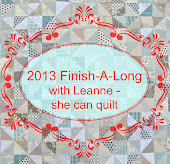I am posting this week's Building Blocks Tuesday VERY early. We are off and running on a quick vacation, and I wanted to make sure everything is set for my lovely bee mates. The linky will stay open until the 9th as usual.
Welcome Make it Modern bee mates! I hope you are ready for a fun, but challenging block.
I feel in love with these feather blocks by
Anna Maria Horner the moment I saw them. She has a
free pattern on her website HERE. They are a great way to use up strips in your scrap basket. The construction is not difficult, as long as you think it out. I've created a partial tutorial for you, just in case. ALSO, in case piecing a bunch of strips is not up your alley. I also created a paper piecing pattern based on Anna's feathers, but not exact. She is a professional after all, and I am just starting to play around with EQ7.
Each block measures 18.5 inches square when completed and has 2 feathers. I would love it if you could use any fall colors you have in your scrap pile. You can see I used plenty of browns, even a touch of dark purple is OK too. Background should be some form of white or grey (hey, I'm not that picky). I even used a white on white for my blocks. For the spine of my feather, I used black, but any really dark color will do fine. Ready to get started?
First, you will need to choose your battle ground: strips or paper?
Anna's Method
If you are choosing Anna's method. Please print out the pattern and templates.
Here is a little trick I learned in
Sarah Fielke's Craftsy class. If you have a template that you will need to use frequently, get some self-laminating sheets. But first cut out your templates, leaving about 1/8 inch around the template lines, and then join together A1 to A2, and F1 to F2 as instructed in the pattern using tape.
Now, place your self laminating sheets on top of the template pieces. Feel free to cut off any excess and use it on another template. You can even layer a bit without having any trouble. Once the laminating sheets are on, cut your templates on the cut line (as shown in the pic above). I think I used just short of two laminating sheets for all these templates. If you printed your templates on cardstock, now they will be SUPER-sturdy. I just used regular copy paper.
Next you will need to get out those strips in fall colors. I found it helpful to arrange them a little by length first, then arrange them in a pleasing color scheme. That way if a strip was a little short, I could add a little to lengthen it. Sew them together. Double check with your Template A to see if you have your strip set wide and long enough.
 |
| template A with right side up |
HOWEVER, here is the tricky part. You will need to get 2 of Template A going in this direction, then 2 of the wrong side of the template - don't you know the darn thing points in the other direction!
 |
| template A with wrong side up. |
I had to sew a few extra strips on to give me enough room to get templates going in both directions. Arrange your templates on your sewn strips, and cut out 2 of Template A showing right side up, and 2 of Template A with the wrong side up (lining up the lines on the template as instructed in the pattern with the seams of your strips). If you added a different color strip to any strips to lengthen them, make sure the seam isn't in the middle of your feather (it will look weird, trust me, I know).
Unfortunately, because of the two directions needed for template A, there is a bit of waste...
Now, I started with a piece of sewn strips around 23 inch square, and I probably could have gotten by with a little less, especially if I wasn't avoiding those seams for adding in the purple. Anna's pattern uses a width of fabric long piece, but she was making a lot more feathers than us!
The rest of the pattern is pretty easy. You add the background to each feather piece, then the spine, then the outside background pieces (make sure the narrow end of the background is lined up with the wide end of the feather - ripped those seams out a few times!), then put the 2 feathers together. TIP: when adding the background pieces, you will have to start with little dog-ears hanging off the sides when you go to join the pieces.
When you are done, square up to 18.5 if needed.
Pretty right!
But perhaps you don't have a bunch of strips in your scrap stash, or maybe the above process seems a little much. OK. Plan B...
Paper Piecing
First download and print out 2 copies of the paper piecing pattern
HERE at google drive. I am just starting to learn EQ7, and I have to apologize, it is not the best print quality. Our scanner here at the house broke, so I had my husband scan it at work. He didn't adjust the darkness, so some of the numbers are a bit obscured. You should still be able to figure it out.
Cut out the pieces, and leave a little extra room around the side seam allowances.
This block is too big for regular sized paper, so I had to cut it up a tad. I found it easier to join the pieces now rather than once the fabric is in place. So, tape those feather pieces back together.
 |
| Caution, piece G is not oriented properly in this picture. |
Please tape Piece A to Piece B, and Piece C to Piece D, then Piece E to Piece F. The feather portion should look like the picture above. Please note, however, that piece G is not turned properly. The longest side of G actually lines up with the length of the feather. Here is a pic of the orientation for reference:
Using your favorite paper piecing technique, start adding small strips to Piece AB and Piece CD, beginning with background in A1 and C1!!
 |
| This is terrible quality pic, but I wanted you to be aware that lining up this piece didn't quite cover the space it needed. |
Caution! Because the strips are angled, you will need a longer piece than you think to cover all the corners of the diagonal. The piece above didn't do the trick even though I centered the new piece on the previous one. You might want to test flip your piece as you are going along, before you sew it, to be sure it will cover the space needed.
Once you are all done adding the strips, join it with the spine (Piece EF) and then with the other half of the feather, like so:
I added pieces G and H after I assembled the feather.
I didn't give you pieces for the side backgrounds, because I found it was just easier if you cut 2 strips approximately 19 inches x 4 inches. Sew them to either side of the feather.
Then trim your feather down to 18.5 inches x 9.5 inches. Yes, this puts the straight grain against the feather instead of the sides of the block, but for me, that is OK.
And there you go! One down, one feather to go.
 |
| Your half block will have a little more background at the top of the feather (I trimmed mine a little too short) |
Then make another feather using your 2nd pattern you printed out and add them together. When you are finished your block should be 18.5 inches square.
Yes, my feather is a bit "thicker" than Anna's, but that is OK with me too. Diversity is nice sometimes.
I also want to mention that if your feathers aren't perfect, that is OK with me too! My spines weren't perfectly angled at all. You can also repeat fabrics as needed. I trust your judgement on what will look nice together. Just think "Fall colors", OK??
You can email me any
hate mail questions by commenting below, clicking on the email link on the "view my complete profile" page, or by Flickr mail.
For everyone else..... what have you been working on this week?
Link up your fabulous blocks. You put a lot of hard work into them - show them off! This free linky will stay open until April 9th, when a new linky will be posted. And spread the word!
Rules:
1) Please link up only to the page in your blog showing your wonderful blocks, not just the blog homepage. Flickr pictures are also OK.
2) Make sure to put your blog name as the description so people know where they are going or the name of your block!
3) Please grab my button and post it in your blog post or sidebar.
4) Visit other linky participants!
Thanks for reading,
Jen

